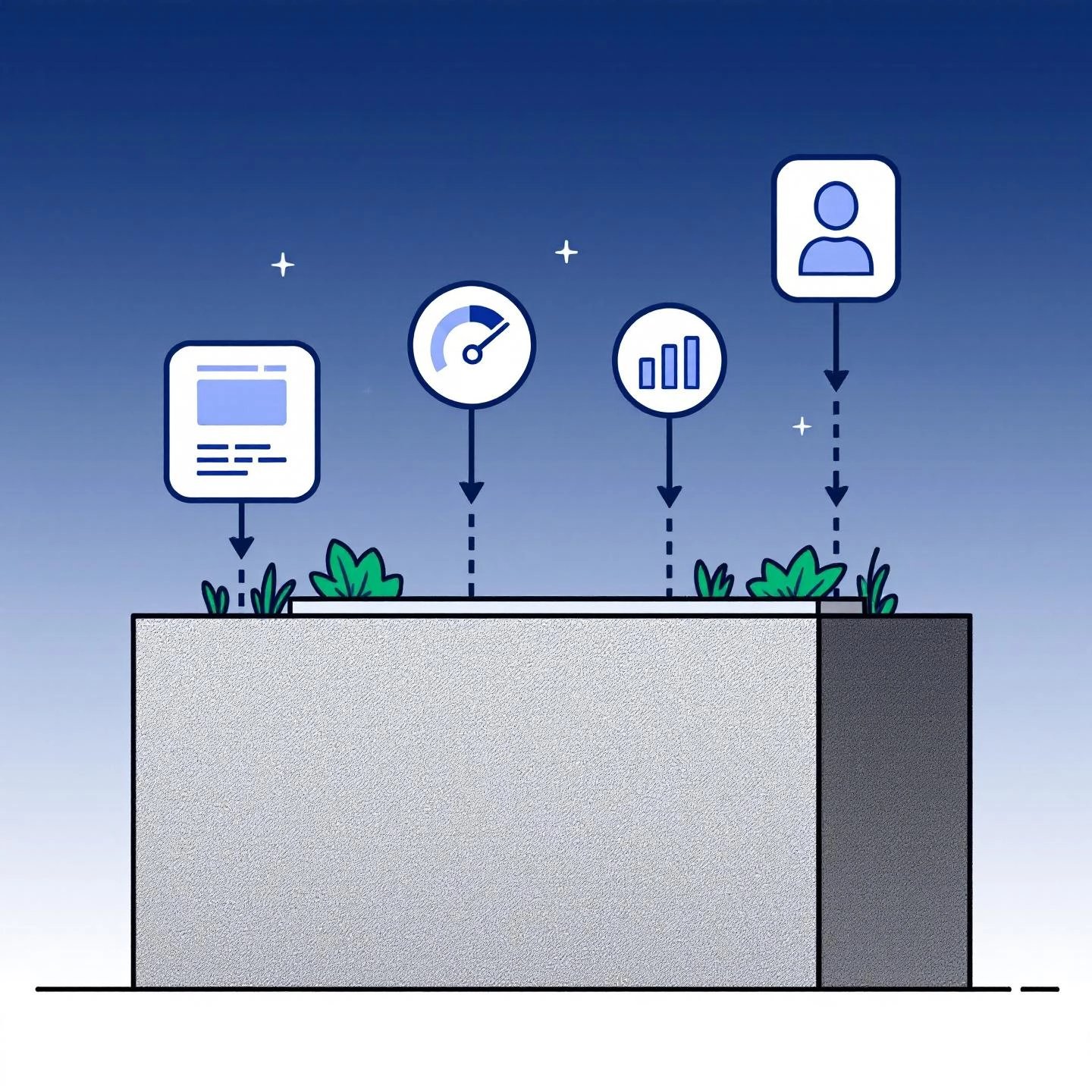Introduction to How to Get Traffic to Your Blog
Have you ever poured your heart into a blog post, hit publish, and waited for readers—only to see barely a trickle of visits? If so, you’re not alone. In today’s crowded online landscape, even the most insightful articles can get lost in the noise. How to get traffic to your blog? It’s a question that frustrates countless new and seasoned bloggers alike, especially when it feels like the rules keep changing and the competition keeps growing.
Sounds complex? It can be. Modern blog traffic strategies go far beyond simply writing great content. With millions of blogs vying for attention, you need a smart, step-by-step approach that covers everything from technical setup to advanced promotion. This guide is your comprehensive blueprint—built on proven tactics and real-world experience—to help you break through the noise and reach the audience your work deserves.
Throughout this series, you’ll learn how to build a solid foundation for sustainable blog growth, create content that stands out, and master the art of promotion across multiple channels. We’ll break down the essentials, such as targeting the right readers, optimizing for search engines, and leveraging social media effectively. You’ll also discover how to analyze your results and refine your approach for ongoing improvement.
But here’s the secret: consistent, expert execution is what separates the blogs that thrive from those that stall. Imagine having a professional team in your corner—handling the strategy, the writing, and the technical details—so you can focus on your strengths. That’s why many successful businesses choose to outsource their blog growth to specialists, ensuring their efforts are both efficient and effective. Whether you’re taking the DIY route or considering a helping hand, this blueprint will set you up for lasting success. Let’s get started!

Building Your Blog's Foundation for Sustainable Traffic
When you start searching for blog traffic for beginners, it’s tempting to focus only on writing more posts. But here’s the truth: long-term, sustainable blog traffic doesn’t happen by accident or by content alone. Behind every successful blog is a solid foundation—a set of critical, non-content elements that quietly drive growth and keep readers coming back. Without these, even the best articles can go unnoticed.
Why Foundations Matter for Sustainable Blog Traffic
Imagine building a house on sand. No matter how beautiful the design, it won’t stand the test of time. The same goes for your blog: without a strong base, your efforts to attract and keep readers may fall flat. So, before you dive into advanced promotion or SEO, take a step back and make sure these essentials are in place. This is especially important for sustainable blog traffic, where consistency and stability matter more than quick wins.
The Core Elements of a High-Traffic Blog Foundation
Let’s break down the must-have steps that set your blog up for long-term growth:
- Define Your Ideal Reader Persona: Who are you writing for? Get specific about your target audience’s interests, challenges, and goals. This clarity will shape your content, voice, and promotional strategies. For example, are your ideal readers busy parents looking for time-saving tips, or are they tech enthusiasts seeking the latest trends?
- Ensure Site Speed and Mobile-Friendliness: Over 62% of users now browse on their phones, and Google prioritizes mobile-optimized sites in search rankings. A slow or clunky blog will drive visitors away fast. Use a responsive design, compress images, and test your site on multiple devices to guarantee a smooth experience. Fast load times and easy navigation are non-negotiable for both readers and search engines.
- Create a Logical Site Structure: Organize your blog so it’s easy for users (and search engines) to find what they need. Use clear categories, intuitive menus, and internal links that guide visitors to related content. A well-structured site not only helps with SEO but also keeps readers engaged and encourages them to explore more.
- Set Up Analytics from Day One: You can’t improve what you don’t measure. Tools like Google Analytics let you track where your traffic comes from, which posts perform best, and how visitors interact with your site. Setting up analytics early means you’ll have the data you need to make smart, growth-focused decisions as your blog evolves.
Putting the Pieces Together
Sounds like a lot? When you break it down, these steps are manageable—and they’re the difference between a blog that fizzles out and one that steadily grows. How to get traffic to your blog? Start by laying this groundwork, and you’ll notice every other strategy works better, from SEO to social sharing. Next, we’ll explore how to create content that not only attracts visitors but also establishes your authority in your niche.

How to Generate Traffic with High-Value Pillar Content
Ever wondered why some blogs become go-to resources in their niche while others struggle to get noticed? The answer often lies in the power of pillar content—a strategy that forms the backbone of sustainable blog growth and authority. If you’re looking for a way to drive consistent, high-quality visitors, mastering pillar content for blog traffic is non-negotiable.
What Is Pillar Content?
Pillar content is an in-depth, comprehensive resource that covers a core topic central to your audience’s needs. Think of it as a digital cornerstone: it’s the main hub that links out to related, more focused articles (called cluster content) and serves as the foundation for your content strategy. For example, a travel blog might have a pillar page called “The Complete Guide to Budget Travel,” which then links to detailed posts on booking cheap flights, finding affordable accommodations, and saving on food abroad.
Unlike standard blog posts, pillar content is designed to be evergreen, regularly updated, and packed with value—making it a magnet for backlinks, shares, and repeat visits. It’s also structured to answer a wide range of user questions, which helps search engines recognize your site as an authority on the subject.
How the Topic Cluster Strategy Works
The topic cluster strategy takes your pillar content to the next level. Here’s how it works:
- Pillar Page: A comprehensive resource covering a broad topic.
- Cluster Content: Supporting articles that dive deeper into specific subtopics related to the pillar.
- Internal Linking: Each cluster article links back to the pillar page, and the pillar links out to the clusters. This interlinking signals to search engines that your site offers authoritative, well-organized coverage.
Imagine your blog as a library: the pillar page is the main section, and each cluster article is a book on a shelf. This structure not only helps readers find exactly what they need but also boosts your topical authority in the eyes of search engines.
Pillar Content vs. Standard Blog Posts: Effort and ROI
| Aspect | Pillar Content | Standard Blog Post |
|---|---|---|
| Depth & Coverage | Comprehensive, covers a broad topic with multiple subtopics | Focuses on a single, narrow topic |
| Word Count | 2,500+ words (often much more) | 800–1,500 words |
| Internal Linking | Acts as a hub, linking to and from cluster articles | May link to a few related posts, but not central to site structure |
| SEO Impact | Builds topical authority, attracts backlinks, ranks for many keywords | Targets specific keywords, limited authority boost |
| Traffic Potential | High, drives both direct and referral traffic over time | Moderate, may see spikes but less consistent |
| Effort Required | High—requires research, outlining, and ongoing updates | Lower—quicker to produce, less ongoing maintenance |
| ROI (Return on Investment) | Exceptional—long-term traffic, leads, and brand authority | Good—short-term engagement, less compounding value |
As you can see, while pillar content demands more upfront effort, the payoff is significant: stronger rankings, more organic traffic, and a reputation as a trusted resource.
Why a Strategic, Expert-Led Approach Wins
How to get traffic to your blog? It’s not just about writing longer posts—it’s about crafting a strategic content ecosystem. This means:
- Conducting in-depth keyword and audience research to choose the right pillar topics.
- Structuring your pillar and cluster content for easy navigation and maximum SEO benefit.
- Regularly updating your pillar pages to keep them current and valuable.
- Promoting your pillar content through outreach, social channels, and partnerships.
But let’s be honest: building a high-performing topic cluster strategy takes time, skill, and consistency. Many businesses find that partnering with professionals—like the team at BlogSpark—unlocks faster results and ensures every piece of content aligns with best practices. Whether you’re doing it yourself or seeking expert help, investing in pillar content is one of the smartest moves you can make for long-term blog growth.
Up next, we’ll show you how to amplify your reach by tapping into the power of social media—so your pillar content gets the attention it deserves.
Driving New Visitors to Your Blog with Social Media
When you think about how to get traffic to your blog for free, does your mind jump straight to social media? It should. Social media isn’t just a megaphone for auto-posting your latest articles—it’s a dynamic, interactive space where you can connect with new audiences, build community, and drive steady streams of visitors to your site. But simply dropping links isn’t enough. The real magic happens when you choose the right platforms, create platform-native content, and engage authentically with communities that care about your topics.
Choosing the Right Platforms for Your Blog
Sounds overwhelming? It doesn’t have to be. Start by asking: where does your target audience hang out online? For some, it’s Instagram or TikTok; for others, it’s LinkedIn or Twitter. Instead of spreading yourself thin, focus on one or two platforms where your ideal readers are most active. This allows you to tailor your approach and build deeper connections, rather than posting generic updates everywhere.
- Instagram: Great for visual content, quick tips, and behind-the-scenes stories.
- Twitter/X: Ideal for sharing quick insights, engaging in trending conversations, and building thought leadership.
- LinkedIn: Perfect for professional or B2B blogs—share articles, insights, and participate in niche groups.
- TikTok: Short, creative videos can introduce your blog to new, younger audiences.
Creating Platform-Native Content
Ever noticed how some posts just “fit” perfectly on a platform? That’s the power of platform-native content. Instead of recycling the same message everywhere, adapt your content to the unique style and features of each platform. For example, use carousel posts or Stories on Instagram, threads on Twitter, and video explainers on TikTok.
- Share behind-the-scenes photos or quick tips as Stories or Reels on Instagram.
- Start a conversation with a question or poll in your LinkedIn group.
- Create short, helpful videos that tease a bigger topic covered in your blog post.
- Use relevant hashtags and keywords to boost discoverability (Sprout Social).
Engaging with Communities and Building Trust
How to get traffic to your blog? It’s not just about your own posts—it’s about joining conversations and building relationships. Get involved in niche communities, comment on others’ content, and share user-generated content (UGC) when possible. Authentic engagement is what turns casual scrollers into loyal readers.
- Respond promptly to comments and messages—over 50% of memorable brands do this, building trust and loyalty.
- Host giveaways or contests that encourage followers to share your blog content.
- Feature reader stories or testimonials to humanize your brand and encourage word-of-mouth sharing.
- Participate in trending conversations, but always add genuine value.
Actionable Tactics for Social Media Blog Promotion
| Social Media Tactic | How It Drives Blog Traffic |
|---|---|
| Optimize your profiles with keywords and website links | Makes your blog easy to find and boosts click-throughs from your bio |
| Post at optimal times for each platform | Maximizes visibility and engagement, leading to more link clicks |
| Share user-generated content (UGC) | Builds trust and encourages followers to visit your blog for more |
| Leverage platform-specific features (e.g., Instagram Stories, LinkedIn Articles) | Engages audiences in their preferred format, increasing the chance they’ll visit your site |
| Monitor analytics and adjust your strategy | Helps you focus on what works, so you can double down on high-traffic tactics |
Remember, social media blog promotion is about more than broadcasting—it’s about listening, connecting, and creating content that feels right at home on each platform. When you invest in authentic engagement and tailored content, you’ll notice your blog traffic steadily rising—often without spending a dime.
Next, we’ll dive into how on-page SEO can turn your best posts into traffic magnets, ensuring your blog is discoverable long after your social posts go live.
Using SEO Best Practices to Increase Blog Traffic Organically
Ever wonder why some blog posts soar to the top of Google while others barely get noticed, even if the content is great? If you’re aiming to increase blog traffic fast and build a sustainable audience, mastering on-page SEO for blog traffic is essential. Let’s break down the key elements—targeting user intent, using semantic keywords, building smart internal links, and writing compelling meta descriptions—that can turn your articles into high-ranking assets.
Targeting User Intent: The Foundation of Effective SEO
When someone searches online, they’re not just typing in keywords—they have a goal in mind. Maybe they want information, to make a purchase, or to compare options. That’s where understanding user intent comes in. Modern search engines, powered by advances like Google’s BERT and RankBrain algorithms, focus on matching content to the deeper intent behind every query.
- Informational intent: Users want to learn something (e.g., "how to get traffic to your blog?").
- Navigational intent: They’re looking for a specific site or page.
- Transactional intent: Ready to buy or take action.
- Commercial investigation: Comparing products or services before deciding.
To increase blog traffic fast, your content should clearly address the type of intent behind your target keywords. For example, if your audience is searching for step-by-step guides, create detailed tutorials rather than just sharing opinions. Always ask: What does my reader want to accomplish with this search?
Semantic Keywords: Going Beyond the Basics
Gone are the days of stuffing a single keyword into your post as many times as possible. Today, search engines use semantic SEO—understanding the context and relationships between words—to rank content. This means your blog should naturally include related terms, synonyms, and long-tail keywords that reflect the full scope of a topic.
- Include your main keyword a few times in your content—especially in the title, first paragraph, and key headings—but keep it natural.
- Research long-tail keywords by checking the "related searches" at the bottom of Google’s results page. Sprinkle these into your article where relevant.
- Answer common questions and cover related subtopics to build topical authority.
By weaving in these semantic signals, you help search engines—and your readers—see that your post is the most comprehensive answer available.
Internal Linking: Boosting Authority and Navigation
Internal links connect one page of your blog to another, guiding both users and search engines through your content. But it’s not just about adding random links—strategic internal linking can increase blog traffic fast by:
- Helping search engines discover and index all your important pages.
- Passing authority from high-performing pages to new or priority content.
- Improving user experience by making it easy to find related information.
Tips for effective internal linking:
- Use descriptive, keyword-rich anchor text (but mix it up—don’t use the same phrase for different pages).
- Link to and from your most important posts, especially pillar content and evergreen guides.
- Place some internal links near the top of your articles to encourage visitors to explore more.
- Regularly audit your internal links to ensure they’re relevant and not broken.
Writing Compelling Meta Descriptions
Meta descriptions are the short summaries that appear below your page title in search results. While they don’t directly impact rankings, a well-written meta description can dramatically increase your click-through rate. Imagine you’re searching for answers—wouldn’t you click the result that promises exactly what you need?
- Keep meta descriptions clear, concise, and under 160 characters.
- Include your main keyword and a compelling reason to click.
- Make each meta description unique—don’t copy and paste across posts.
SEO Is an Ongoing, Technical Process
How to get traffic to your blog? It’s not a one-and-done effort. SEO for blog traffic requires ongoing attention, technical know-how, and regular updates. Algorithms change, new competitors emerge, and user behavior evolves. To stay ahead, regularly review your analytics, update old posts, and refine your keyword and linking strategies.
By focusing on user intent, semantic keywords, smart internal linking, and enticing meta descriptions, you’ll turn good articles into traffic magnets—and set your blog up for steady, organic growth. Next, we’ll explore how email marketing can help you bring readers back again and again, building a loyal audience around your blog.

How Can I Get More Traffic to My Blog with Email Marketing?
When was the last time you clicked a social link, read a blog post, and then promptly forgot about the site? It happens to everyone. But imagine if, instead, you’d been invited to join a community—one where you get valuable updates, exclusive content, and a direct line to the blogger. That’s the power of blog traffic email marketing: it transforms casual visitors into loyal fans who return again and again.
Why Email Marketing Is Your Blog’s Secret Weapon
While social media platforms can change their rules overnight, your email list is an audience you truly own. With a well-crafted email strategy, you can reliably grow blog audience numbers and drive repeat traffic—no algorithm changes required. So, how to get traffic to your blog? By building and nurturing an engaged email list, you create a steady stream of readers who are eager for your latest posts.
The Two-Step Email Marketing Blueprint
Getting started doesn’t have to be intimidating. Here’s a proven, two-step process:
- Capture Emails with Irresistible Lead MagnetsPeople need a reason to hand over their email address. Lead magnets—free, valuable resources—make subscribing a no-brainer. Think of them as a thank-you gift for joining your list.
- Nurture Subscribers with Valuable ContentOnce someone subscribes, you keep the momentum going by delivering helpful, engaging emails. These could be welcome sequences, curated blog highlights, or exclusive tips that keep your audience coming back for more (Grace + Vine Studios).
Lead Magnet Ideas to Grow Your Blog Audience
Wondering what kind of lead magnet will work for your readers? Here are practical options you can tailor to your blog’s niche:
- Exclusive eBooks or Guides – Package your best tips or most popular posts into a downloadable PDF.
- Cheat Sheets or Checklists – Create quick-reference resources your audience can use right away (e.g., a recipe cheat sheet, travel packing list, or SEO checklist).
- Email Mini-Courses – Offer a short email series that teaches a specific skill, such as “5 Days to Better Food Photography” or “Blog Launch Bootcamp.”
- Printable Worksheets or Planners – Help readers organize their goals or projects related to your niche.
- Access to Exclusive Content – Promise early access to new posts, members-only articles, or behind-the-scenes updates.
- Resource Libraries – Give subscribers entry to a collection of templates, swipe files, or curated resources.
- Contests or Giveaways – Encourage sign-ups by offering a chance to win a relevant prize.
Best Practices for Nurturing Your Email List
Once you’ve captured those emails, what’s next? Start with a warm, personal welcome sequence that introduces yourself and sets expectations. Then, keep your audience engaged by:
- Sharing your latest or most popular blog posts directly in your newsletter.
- Curating helpful tips, stories, or resources that complement your blog content.
- Segmenting your list by interests or experience level, so readers get content that’s truly relevant to them.
- Asking questions or inviting replies to spark real conversations.
Remember, your email subscribers are your most invested readers. Treat them like VIPs, and they’ll reward you with loyalty, feedback, and word-of-mouth referrals. As you master blog traffic email marketing, you’ll see your audience not just grow—but stick around for the long haul.
Up next, we’ll explore how blogger outreach and collaborations can help you tap into new audiences and build your blog’s authority even further.
Boosting Your Reach Through Blogger Outreach and Collaborations
Ever felt like you’ve done everything right—great content, active social media, and a solid email list—yet your blog growth still plateaus? That’s when blogger outreach for traffic and collaboration blog promotion become your secret weapons. These strategies not only open doors to new audiences but also help you earn the high-quality backlinks that search engines and AI platforms now value more than ever.
Why Blogger Outreach and Collaborations Matter
Let’s start with the basics: backlinks are still one of the most reliable signals for SEO and authority, but not all links are created equal. Links and brand mentions from respected blogs in your niche signal trust and relevance to both search engines and AI-powered recommendation systems. Plus, when another blogger shares your work or you co-create content, you instantly tap into their audience—often resulting in a surge of referral traffic and long-term brand awareness.
- Expand your reach: Collaborating with bloggers pools audiences, multiplying exposure for both parties.
- Earn valuable backlinks: High-authority links boost your rankings and increase your blog’s visibility in search results.
- Build credibility and trust: Being recommended by another respected voice in your niche enhances your reputation.
- Discover new ideas and skills: Partnerships often spark creative content formats and introduce you to new promotional tactics.
Best Practices for Effective Blogger Outreach
Sounds complex? It’s easier when you follow a proven process. Here’s a side-by-side look at what works—and what doesn’t—when reaching out to fellow bloggers:
| Outreach Practice | Effective Approach | Ineffective Approach |
|---|---|---|
| Research | Personalize your pitch by referencing their recent content and audience | Send generic, mass emails with no context |
| Value Exchange | Offer something valuable—guest post, expert quote, or co-created resource | Ask for a link or share without providing value in return |
| Follow-Up | Send one polite, timely follow-up if there’s no response | Spam with repeated reminders or pressure tactics |
| Professionalism | Be clear, concise, and respectful of their time and audience | Overly casual, vague, or demanding communication |
| Collaboration Type | Suggest specific projects: guest posts, joint webinars, or resource roundups | Vague requests to "work together" with no clear plan |
Collaboration Blog Promotion: Multiply Your Impact
Imagine co-hosting a challenge, creating a joint eBook, or running a multi-blog event. These collaboration blog promotion tactics not only combine audiences but also foster accountability, spark creative ideas, and build lasting relationships within your niche. The result? More eyes on your content, higher engagement, and opportunities for future partnerships.
- Multi-blog events can attract sponsors, prizes, and media attention.
- Sharing expertise with a partner helps both of you grow faster and smarter.
- Regular accountability check-ins ensure deadlines are met and goals are achieved.
Professionalism: The Key to Successful Outreach
How to get traffic to your blog? Approach outreach with the same professionalism you’d expect in any business relationship. Personalize your messages, respect others’ time, and always deliver value first. Building genuine connections—rather than chasing quick wins—leads to more meaningful collaborations and long-term growth.
Remember, executing blogger outreach and collaborations at a high level takes time and expertise. Many businesses choose to partner with professional teams to handle strategy, research, and relationship-building—ensuring every outreach effort is both efficient and effective. As you master these tactics, you’ll not only earn more backlinks and traffic, but also become a respected voice in your community.
Next, we’ll explore how to revive older blog posts for even more traffic—unlocking the hidden value in your existing content library.

Reviving Old Posts to Gain More Blog Traffic
Ever feel like your best blog posts have faded into the background, no longer pulling in the readers they once did? You’re not alone. As your blog grows, it’s easy for older content to become outdated or buried, even if the topics are still relevant. The good news: you can breathe new life into these articles—and unlock a powerful, often-overlooked strategy for sustainable growth—through historical optimization for blog traffic.
What Is Historical Optimization?
Historical optimization is the process of updating and relaunching older blog posts to make them more relevant, accurate, and appealing for today’s searchers. Instead of letting all that hard work go to waste, you can update old blog posts to improve their search rankings, boost organic traffic, and re-engage your audience. This isn’t just theory: marketers who regularly refresh content are 2.8 times more likely to see strong performance results.
Step-by-Step: How to Get Traffic to Your Blog with Historical Optimization
- Audit Your Existing Content: Start by reviewing your content library. Use analytics tools to spot posts with declining traffic, outdated information, or low engagement. Look for formerly high-performing articles that have slipped in rankings or posts sitting just outside the top 10 search results.
- Prioritize What to Update: Focus on posts that have the most potential—those still attracting some traffic, or ranking for valuable keywords. Don’t try to update everything at once; start with one or two posts to measure impact.
- Refresh Content and SEO Elements:
- Update facts, statistics, and examples to reflect the latest trends or data.
- Revise headlines and meta tags to improve click-through rates and keyword targeting.
- Add new sections, visuals, or internal links to enhance value and user experience.
- Replace or fix outdated external and internal links.
- Optimize for new or emerging keywords based on current search intent.
- Republish and Promote: Change the publication date, if appropriate, and clearly signal that the content is updated. Share the refreshed post across your social channels, email list, and even consider pitching it to industry newsletters for extra exposure.
- Track Performance Over Time: Monitor key metrics—traffic, rankings, engagement, and conversions—before and after your updates. Set reminders to review progress at one, three, and six months, so you can see what’s working and refine your approach.
“Updating old blog posts is one of the highest-ROI tactics for established blogs. It leverages the authority and backlinks you’ve already built, while saving time compared to creating new content from scratch.”
Tips for Making the Most of Historical Optimization
- Maintain the same URL whenever possible to preserve SEO value and backlinks.
- Highlight new insights or actionable tips in your refreshed posts to entice both returning and new readers.
- Use tools like Google Analytics and Search Console to spot quick wins and measure the impact of your updates.
- Set a regular schedule—monthly or quarterly—to review and refresh aging content, keeping your blog competitive and authoritative.
How to get traffic to your blog? Sometimes, the answer isn’t creating more—it’s making the most of what you already have. By embracing historical optimization, you’ll turn forgotten articles into fresh traffic magnets, maximize your content investment, and set your blog up for long-term growth. Next, we’ll look at how data analysis can help you refine every aspect of your traffic strategy for continuous improvement.
Analyzing Your Data to Continuously Improve Blog Traffic
Ever feel like you’re doing everything right—publishing great posts, promoting on social, and optimizing for SEO—but your traffic still isn’t where you want it? Here’s the missing piece: the most successful bloggers know how to analyze blog traffic and use those insights to refine their strategy, week after week. The truth is, growth isn’t a one-time event; it’s a cycle of measurement, learning, and improvement.
Why Data Analysis Is the Heart of Blog Growth
Think of your blog as a living, evolving project. Instead of guessing what works, you can use data to see exactly how visitors find and interact with your content. This isn’t just about counting pageviews—it’s about identifying which blog traffic metrics matter most, so you can double down on what’s effective and fix what’s not.
- Continuous improvement means regularly reviewing your analytics, spotting trends, and making small, strategic changes that add up over time.
- With tools like Google Analytics and Search Console, you’ll move from “throwing stuff at the wall” to making informed, purposeful decisions.
- By tracking the right metrics, you’ll know which posts drive the most traffic, which sources are most effective, and how well your blog converts readers into subscribers or customers.
Essential Tools: Google Analytics and Search Console
Getting started is easier than you might think. Here’s how these two free tools work together to help you analyze blog traffic and fuel your growth:
- Google Analytics: Tracks how many people visit your blog, where they come from, and how they engage with your content. You’ll see which posts get the most views, where users drop off, and which channels (search, social, referral) are performing best (Blobr.io).
- Google Search Console: Focuses on your organic search performance. It shows what keywords bring visitors to your blog, your average rankings, and how often people click through from search results.
Key Metrics and What They Tell You
Not sure what to look for? Here’s a handy table linking the most important blog traffic metrics to actionable next steps:
| Metric | Where to Find It | What It Reveals | Actionable Insight |
|---|---|---|---|
| Page Views & Sessions | Google Analytics: Pages and Screens Report | Which posts are most popular and engaging | Replicate top-performing topics or update high-traffic posts for even better results |
| Traffic Sources | Google Analytics: Traffic Acquisition Report | Where your visitors are coming from (search, social, referral, direct) | Invest more in high-performing channels; adjust underperforming ones |
| Average Engagement Time | Google Analytics: Pages and Screens Report | How long users stay on your posts | Improve content quality or add internal links to boost engagement |
| Click-Through Rate (CTR) | Google Search Console: Performance Report | How often people click your blog in search results | Revise titles and meta descriptions to make them more compelling |
| Average Position | Google Search Console: Performance Report | Your average ranking for target keywords | Update and optimize content to climb higher in search results |
| User Flow | Google Analytics: Users Flow Report | How visitors navigate through your blog and where they drop off | Add clearer calls-to-action or internal links to guide readers further |
Making Data-Driven Improvements
Imagine you notice a blog post with high impressions but a low click-through rate. That’s your cue to tweak the headline or meta description. Or, if your analytics show most visitors come from Instagram, you might double down on social content and collaborations. The key is to treat every data point as a clue—helping you refine your promotion, content, and user experience.
How to get traffic to your blog? By embracing a data-driven approach, you’ll continuously optimize what’s working and quickly address what’s not. Over time, these small, strategic tweaks compound into significant, sustainable growth.
For many businesses, this ongoing analysis can be time-consuming. That’s why partnering with professionals—like the team at BlogSpark—can streamline the process, helping you turn raw numbers into actionable strategies for blog traffic growth. As you build your own process, remember: the best blogs never stop learning, testing, and improving. In the next and final section, we’ll tie together all the pillars of this blueprint for consistent, long-term blog growth.
Your Blueprint for Consistent Blog Traffic Growth
When you step back and look at the journey so far, what’s the real secret to consistent blog traffic growth? It’s not a single hack, tool, or viral post—it’s the sum of strategic, repeatable actions that build on each other over time. If you’ve ever wondered, “How to get traffic to your blog?”—the answer is a blueprint built on four essential pillars, each reinforcing the next.
The Four Pillars of Sustainable Blog Growth
- Solid Foundation: Every high-traffic blog starts with the basics: a clear audience persona, fast and mobile-friendly site, logical structure, and robust analytics. These elements ensure every tactic you deploy later has maximum impact (Classy Career Girl).
- Pillar Content and Topic Clusters: Instead of chasing fleeting trends, invest in comprehensive, evergreen resources that establish your authority. Pillar content, supported by targeted cluster posts, acts as a magnet for both readers and search engines.
- Strategic Promotion: From social media engagement to email marketing and outreach, the most successful blogs don’t just publish—they promote. Each channel brings unique opportunities to reach new audiences and bring past visitors back for more.
- Data-Driven Optimization: Growth isn’t static. By regularly analyzing your results and refining your approach, you ensure your blog adapts to changes in algorithms, audience preferences, and the competitive landscape.
Why Execution Matters More Than Ideas
Sounds straightforward? The reality is, implementing these blog traffic solutions with skill and consistency is what separates thriving blogs from those that stall. Each pillar requires time, expertise, and ongoing attention. It’s easy to get overwhelmed—especially as your content library and promotional channels grow.
Imagine: What if you could focus on your core strengths while a team of experts handled every detail—from keyword research and pillar content creation to technical SEO and analytics? That’s why many businesses, agencies, and solopreneurs turn to solutions like BlogSpark. With intelligent automation, expert-led strategy, and seamless integration, BlogSpark empowers you to scale your content, maintain quality, and drive real results—without burning out or losing sight of your goals.
Putting the Blueprint Into Action
- Start by assessing your current foundation: Is your site fast, mobile-friendly, and easy to navigate?
- Identify opportunities for high-value pillar content and build topic clusters around them.
- Map out a promotion plan that leverages social, email, and outreach—don’t rely on just one channel.
- Make data analysis a regular habit, using insights to double down on what’s working and fix what’s not.
Remember, consistent blog traffic growth isn’t about chasing the latest trend or shortcut. It’s about building a system that compounds over time—one that attracts new readers, nurtures loyal fans, and turns your blog into a true business asset. If you’re ready to see real results and want to accelerate your journey, consider partnering with a trusted solution like BlogSpark. Their blend of strategy, technology, and expert support can help you achieve sustainable growth—so you can focus on what matters most: delivering value to your audience.
Frequently Asked Questions About Getting Blog Traffic
1. How can I get 1000 visitors to my blog?
To reach 1000 daily visitors, focus on creating high-value pillar content, optimize for SEO, and promote your posts on the social platforms where your audience is most active. Engage with communities, use email marketing to nurture repeat visits, and regularly update your older posts for improved search rankings. Consistent, data-driven improvements and professional tools like BlogSpark can accelerate your growth.
2. Why is my blog not getting any traffic?
Common reasons include lack of SEO optimization, poor site speed, insufficient promotion, and not understanding your target audience. Ensure your blog is technically sound, content is optimized for user intent and search engines, and that you’re actively sharing your posts across social and email channels. Analyzing your data will help pinpoint and fix bottlenecks.
3. What type of blog attracts the most traffic?
Niche blogs focused on a specific topic often draw the most targeted traffic, as they offer depth and expertise. Building pillar content and topic clusters around popular subjects in your niche, combined with strong promotion and SEO, can help your blog become a go-to resource and attract consistent visitors.
4. How do I make my blog easy to find on search engines?
Optimize your post titles and meta descriptions with relevant keywords, structure your site with logical categories and internal links, and ensure your blog is mobile-friendly and loads quickly. Regularly update content and use tools like Google Analytics and Search Console to track and improve your visibility.
5. What are effective strategies for promoting my blog for free?
Leverage social media by sharing platform-native content and engaging with relevant communities. Use email marketing to build a loyal audience, collaborate with other bloggers for backlinks and exposure, and update older posts for better SEO. These free tactics, when executed consistently, can drive steady blog traffic.




